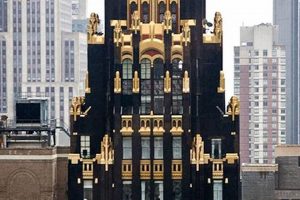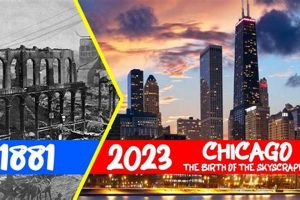In the realm of architecture, skyscrapers have left an indelible mark on skylines across the globe. These towering structures, reaching hundreds of meters into the sky, are not just symbols of urban development but also testaments to human ambition and engineering prowess. Early skyscrapers, which emerged in the late 19th and early 20th centuries, played a pivotal role in shaping the modern cityscape and revolutionizing the way we live and work.
The construction of early skyscrapers was driven by several factors, including the need for more space in densely populated urban areas, advancements in building technologies, and the desire to create iconic landmarks. These early pioneers in vertical construction faced numerous challenges, from structural stability to elevator systems and fire safety. However, through innovation and collaboration, engineers and architects overcame these obstacles, paving the way for the skyscrapers we know today.
The impact of early skyscrapers extended far beyond their physical presence. They transformed cities into vibrant hubs of commerce, culture, and living, attracting businesses, residents, and visitors alike. Moreover, they became symbols of progress and prosperity, inspiring similar developments in cities around the world. Today, early skyscrapers continue to captivate us with their architectural beauty and historical significance, reminding us of the ingenuity and vision that shaped our built environment.
1. Height
As early skyscrapers soared to new heights, they redefined the urban landscape and revolutionized architecture. Their unprecedented stature had a profound impact on skylines, creating iconic landmarks and reshaping the way we perceive cities.
- Vertical Dominance: These towering structures established a new vertical dimension in urban environments, creating a sense of awe and grandeur.
- Urban Landmarks: Early skyscrapers became instantly recognizable symbols of their respective cities, defining skylines and serving as points of reference.
- Engineering Marvels: Achieving such heights required innovative engineering solutions, pushing the boundaries of structural design and construction techniques.
- New Perspectives: The elevated vantage points offered by early skyscrapers provided breathtaking panoramic views, transforming the way people experienced their cities.
The height of early skyscrapers was not merely a matter of aesthetics; it was a testament to human ambition and technological advancements. These buildings pushed the limits of what was considered possible, forever changing the face of architecture and urban development.
2. Innovation
The construction of early skyscrapers was a testament to the pioneering spirit of engineers and architects. Faced with the challenge of building structures that reached unprecedented heights, they developed innovative engineering techniques and materials that revolutionized architecture and construction.
One of the most significant innovations was the development of the steel frame. Steel’s strength and flexibility allowed architects to create buildings that were both tall and slender. This was a major departure from traditional construction methods, which relied on thick masonry walls to support the weight of the building. The steel frame also made it possible to create large open spaces, which were ideal for offices and other commercial uses.
Another important innovation was the development of new materials, such as reinforced concrete. Reinforced concrete is a composite material made of concrete and steel. It is much stronger than concrete alone, and it can be used to create structures that are both lightweight and durable. Reinforced concrete was used extensively in the construction of early skyscrapers, and it remains an important material in modern construction.
The combination of innovative engineering techniques and new materials made it possible to build early skyscrapers that were taller, stronger, and more efficient than any previous buildings. These structures transformed the urban landscape and set the stage for the modern skyscraper.
3. Design
Early skyscrapers were not just feats of engineering; they were also works of art. Architects and designers lavished attention on the facades and interiors of these buildings, creating ornate and intricate details that showcased their architectural prowess.
- Historical Influences: Early skyscrapers drew inspiration from various architectural styles, including Gothic, Renaissance, and Art Deco. This resulted in a rich tapestry of decorative elements, such as pointed arches, elaborate cornices, and intricate carvings.
- Symbolism and Identity: The facades of early skyscrapers often reflected the aspirations and values of the cities and institutions they represented. For example, the Woolworth Building in New York City featured intricate terracotta ornamentation that symbolized the wealth and prosperity of the city.
- Artistic Collaboration: Architects worked closely with sculptors, painters, and other artisans to create cohesive and visually stunning designs. This collaboration resulted in integrated works of art that extended beyond the building’s structure.
- Technological Advancements: The development of new materials and construction techniques allowed architects to explore new design possibilities. For example, the use of steel frames and curtain walls enabled the creation of large windows and open spaces, which were decorated with intricate metalwork and stained glass.
The ornate facades and intricate details of early skyscrapers were not just decorative embellishments; they were integral to the buildings’ overall design and significance. These architectural elements reflected the aspirations and values of the time, showcased the skill and creativity of architects and artisans, and continue to inspire awe and admiration today.
4. Function
Early skyscrapers were not just architectural marvels; they were also functional buildings that accommodated a wide range of uses. This diversity of function was a key factor in their success and contributed to the transformation of cities into vibrant hubs of commerce, culture, and living.
- Commercial Hubs: Early skyscrapers provided much-needed office space for businesses, allowing them to centralize their operations and be close to clients and partners. Th
is concentration of businesses created vibrant commercial districts and facilitated economic growth. - Vertical Communities: Many early skyscrapers also included residential units, allowing people to live in close proximity to their workplaces and urban amenities. This mixed-use approach fostered a sense of community and convenience, reducing the need for long commutes and creating more livable urban environments.
- Cultural Centers: Some early skyscrapers incorporated cultural spaces, such as theaters, concert halls, and museums. These venues enriched the cultural landscape of cities and provided entertainment and educational opportunities for residents and visitors alike.
- Transportation Hubs: Early skyscrapers often had direct access to public transportation, such as subway stations or elevated train lines. This integration made it easy for tenants and visitors to commute and access other parts of the city, further enhancing the convenience and connectivity of these vertical communities.
The diverse functions of early skyscrapers made them essential components of urban life. They not only provided practical solutions for space constraints but also contributed to the economic, social, and cultural fabric of cities. This multifunctional approach remains a key consideration in modern skyscraper design, ensuring that these buildings continue to be dynamic and integral parts of the urban landscape.
5. Symbolism
Early skyscrapers were more than just tall buildings; they were powerful symbols of urban growth and economic prosperity. Their towering heights and impressive facades reflected the ambitions and achievements of the cities and corporations they represented.
- Civic Pride: Early skyscrapers were often built to showcase the wealth and power of a city. They were symbols of civic pride and ambition, and their construction often coincided with periods of economic growth and expansion.
- Corporate Identity: Early skyscrapers were also used by corporations to project an image of strength and stability. These buildings were designed to impress clients and investors, and they often featured the company’s logo or other branding elements.
- Economic Vitality: The construction of early skyscrapers often spurred economic development in the surrounding area. These buildings attracted businesses and workers, and they helped to create vibrant commercial districts.
- Technological Progress: Early skyscrapers were also symbols of technological progress. Their construction required the development of new engineering techniques and materials, and they showcased the latest advances in architecture and design.
The symbolism of early skyscrapers is still evident today. These buildings continue to be iconic landmarks in many cities, and they are often seen as symbols of urban power and economic prosperity.
6. Density
The construction of early skyscrapers was driven, in part, by the need to address space constraints in growing cities. As urban populations swelled and land became scarce, building upwards became a practical solution to accommodate the growing number of people and businesses.
Early skyscrapers made efficient use of limited land space by stacking multiple stories on top of each other. This vertical growth allowed cities to accommodate more people and businesses within a smaller footprint, reducing urban sprawl and preserving valuable land for other uses, such as parks and green spaces.
One notable example of this space-saving approach is the Flatiron Building in New York City. Completed in 1902, the Flatiron Building is one of the earliest skyscrapers and its triangular shape was designed to maximize the use of the available land at the intersection of Broadway and Fifth Avenue.
By building upwards, early skyscrapers not only addressed space constraints but also had a transformative impact on urban development. They allowed cities to grow vertically, creating denser and more vibrant urban environments. This concentration of people and businesses fostered economic growth, innovation, and cultural exchange.
7. Legacy
The legacy of early skyscrapers is evident in their enduring presence as architectural landmarks. These towering structures continue to inspire awe and admiration, serving as testaments to the ingenuity, ambition, and artistic vision of their creators.
- Historical Significance: Many early skyscrapers are recognized for their historical significance, representing important milestones in architectural development. They embody the technological advancements and design innovations that shaped the built environment of the early 20th century.
- Architectural Beauty: Early skyscrapers are often admired for their architectural beauty, showcasing a variety of styles and design elements. Their ornate facades, intricate details, and soaring heights contribute to their aesthetic appeal and make them iconic landmarks.
- Cultural Symbolism: Some early skyscrapers have become cultural symbols, representing the aspirations and values of the cities in which they are located. They serve as landmarks that evoke a sense of identity and pride among residents and visitors alike.
- Tourist Attractions: Many early skyscrapers are popular tourist attractions, drawing visitors from around the world. Their architectural significance, historical value, and scenic views make them must-see destinations for travelers interested in architecture, history, and urban exploration.
The enduring legacy of early skyscrapers lies in their ability to transcend their function as mere buildings and become symbols of architectural achievement, cultural heritage, and urban identity. They continue to captivate and inspire, serving as a reminder of the human ingenuity and ambition that shaped the modern world.
Frequently Asked Questions about Early Skyscrapers
This section addresses common questions and misconceptions surrounding early skyscrapers, providing concise and informative answers.
Question 1: What factors contributed to the emergence of early skyscrapers?
Early skyscrapers emerged in the late 19th and early 20th centuries due to a confluence of factors, including rapid urbanization, advancements in building technologies (particularly the steel frame), and the desire to create iconic landmarks and symbols of urban power.
Question 2: What were some of the engineering challenges involved in constructing early skyscrapers?
Early skyscraper construction presented several engineering challenges, such as how to create structures that were both tall and stable, how to design efficient elevator systems, and how to ensure fire safety in high-rise buildings.
Question 3: How did early skyscrapers impact urban development?
Early skyscrapers had a profound impact on urban development by allowing cities to grow vertically, reducing urban sprawl, and creating denser, more vibrant urban environments. They also attracted businesses and workers
, fostering economic growth and innovation.
Question 4: What architectural styles influenced the design of early skyscrapers?
Early skyscrapers drew inspiration from various architectural styles, including Gothic, Renaissance, Art Deco, and Chicago School architecture. This resulted in a rich diversity of design elements, such as pointed arches, elaborate cornices, intricate carvings, and geometric ornamentation.
Question 5: What is the legacy of early skyscrapers?
Early skyscrapers continue to be admired for their architectural beauty, historical significance, and cultural symbolism. Many are recognized as landmarks and tourist attractions, serving as reminders of the ingenuity and ambition that shaped the modern built environment.
Question 6: How do early skyscrapers compare to modern skyscrapers?
While early skyscrapers laid the foundation for modern skyscraper design, there are key differences between the two. Modern skyscrapers are typically taller, more energy-efficient, and incorporate advanced technologies and sustainable design principles. However, early skyscrapers remain significant for their pioneering spirit and their enduring impact on architecture and urban development.
These FAQs provide a concise overview of the key aspects surrounding early skyscrapers, addressing common questions and misconceptions. By understanding these aspects, we can better appreciate the historical significance, architectural value, and lasting legacy of these iconic structures.
Transition to the next article section:
The following section will delve deeper into the architectural innovations and design principles that shaped early skyscrapers, exploring how they continue to influence modern skyscraper design.
Early Skyscrapers
Early skyscrapers, with their towering heights and architectural grandeur, continue to captivate and inspire. Here are a few tips to enhance your appreciation for these iconic structures:
Tip 1: Explore their historical context: Delve into the historical events and technological advancements that shaped the construction of early skyscrapers. Understanding the challenges and innovations of their time will deepen your appreciation.
Tip 2: Observe their architectural details: Pay attention to the intricate facades, decorative elements, and structural features of early skyscrapers. These details often reflect the architectural styles and societal values of the era.
Tip 3: Consider their impact on urban development: Early skyscrapers transformed cities by allowing for vertical growth and creating dense urban environments. Reflect on how these structures shaped the social and economic dynamics of their surroundings.
Tip 4: Visit and experience them firsthand: If possible, visit early skyscrapers to experience their grandeur in person. Take guided tours or simply admire their presence from afar. The immersive experience will provide a deeper understanding of their scale and impact.
Tip 5: Learn about their preservation efforts: Many early skyscrapers have been preserved and restored to maintain their historical integrity. Support organizations and initiatives dedicated to preserving these architectural treasures for future generations.
Tip 6: Appreciate their enduring legacy: Early skyscrapers continue to influence modern architecture and design. Recognize their role as pioneers in engineering and construction, and appreciate their lasting contribution to the built environment.
Tip 7: Draw inspiration from their design principles: The innovative design principles employed in early skyscrapers, such as the use of steel frames and curtain walls, offer valuable lessons for contemporary architecture. Consider how these principles can inspire sustainable and efficient building practices.
Early skyscrapers stand as testaments to human ingenuity, architectural prowess, and urban development. By embracing these tips, you can develop a deeper appreciation for these iconic structures and their enduring legacy.
Conclusion
Early skyscrapers, with their towering heights and architectural grandeur, emerged as symbols of progress, ambition, and urban transformation. Their innovative engineering and design principles revolutionized construction and redefined the city skylines of the early 20th century.
These iconic structures not only accommodated diverse functions but also embodied the aspirations and values of their time. They continue to inspire awe and admiration, serving as testaments to human ingenuity and the enduring power of architecture. Preserving and appreciating these early skyscrapers is crucial for safeguarding our architectural heritage and drawing inspiration for sustainable and innovative urban development in the future.







